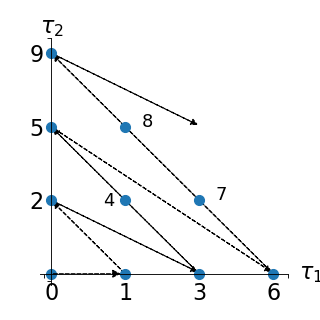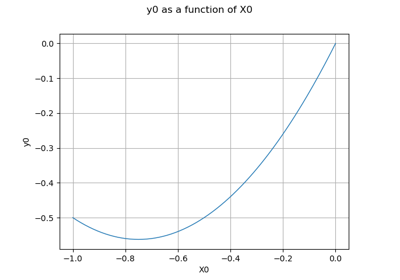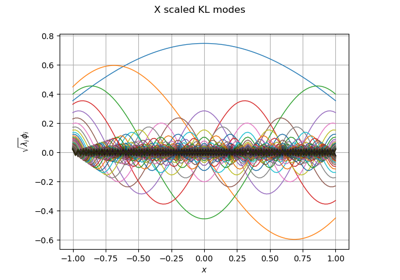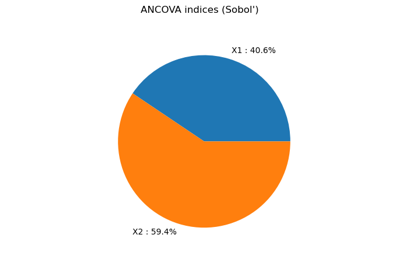LinearEnumerateFunction¶
- class LinearEnumerateFunction(*args)¶
Linear enumerate function.
- Parameters:
- dimint
Dimension.
Notes
Given an input random vector
with prescribed probability density function (PDF)
, it is possible to build up a polynomial chaos (PC) basis
. Of interest is the definition of enumeration strategies for exploring this basis, i.e. of suitable enumeration functions
from
to
, which creates a one-to-one mapping between an integer
and a multi-index
.
Let us first define the total degree of any multi-index
in
by
. A natural choice to sort the PC basis (i.e. the multi-indices
) is the lexicographical order with a constraint of increasing total degree. Mathematically speaking, a bijective enumeration function
is defined by:
such that:
and
Such an enumeration strategy is illustrated in a two-dimensional case (i.e.
) in the figure below:
(
Source code,png)
This corresponds to the following enumeration of the multi-indices:
j
0
{0, 0}
1
{1, 0}
2
{0, 1}
3
{2, 0}
4
{1, 1}
5
{0, 2}
6
{3, 0}
7
{2, 1}
8
{1, 2}
9
{0, 3}
Examples
>>> import openturns as ot >>> # 4-dimensional case >>> enumerateFunction = ot.LinearEnumerateFunction(4) >>> for i in range(9): ... print(enumerateFunction(i)) [0,0,0,0] [1,0,0,0] [0,1,0,0] [0,0,1,0] [0,0,0,1] [2,0,0,0] [1,1,0,0] [1,0,1,0] [1,0,0,1]
Methods
getBasisSizeFromTotalDegree(maximumDegree)Get the basis size corresponding to a total degree.
Accessor to the object's name.
Return the dimension of the EnumerateFunction.
getMaximumDegreeCardinal(maximumDegree)Get the number of multi-indices of total degree lower or equal to a threshold.
getMaximumDegreeStrataIndex(maximumDegree)Get the largest index of the strata containing multi-indices lower or equal to the given maximum degree.
getName()Accessor to the object's name.
getStrataCardinal(strataIndex)Get the number of multi-indices in the basis inside a given strata.
getStrataCumulatedCardinal(strataIndex)Get the number of multi-indices in the basis inside a range of stratas.
Accessor to the upper bound.
hasName()Test if the object is named.
inverse(indices)Get the antecedent of a indices list in the EnumerateFunction.
setDimension(dimension)Set the dimension of the EnumerateFunction.
setName(name)Accessor to the object's name.
setUpperBound(upperBound)Accessor to the upper bound.
- __init__(*args)¶
- getBasisSizeFromTotalDegree(maximumDegree)¶
Get the basis size corresponding to a total degree.
- Parameters:
- max_degint
Maximum total degree.
- Returns:
- sizeint
Number of multi-indices in the basis of total degree
.
Notes
In the specific context of a linear enumeration (
LinearEnumerateFunction) this is also the cumulated cardinal of stratas up to max_deg.Examples
>>> import openturns as ot >>> dim = 2 >>> enum_func = ot.LinearEnumerateFunction(dim) >>> enum_func.getBasisSizeFromTotalDegree(3) 10 >>> enum_func.getStrataCumulatedCardinal(3) 10
- getClassName()¶
Accessor to the object’s name.
- Returns:
- class_namestr
The object class name (object.__class__.__name__).
- getDimension()¶
Return the dimension of the EnumerateFunction.
- Returns:
- dimint,
Dimension of the EnumerateFunction.
- dimint,
- getMaximumDegreeCardinal(maximumDegree)¶
Get the number of multi-indices of total degree lower or equal to a threshold.
- Parameters:
- max_degint
Maximum total degree.
- Returns:
- cardinalint
Number of multi-indices in the basis of total degree
.
Notes
In the specific context of a linear enumeration (
LinearEnumerateFunction) this is also the cumulated cardinal of stratas of index.
Examples
>>> import openturns as ot >>> dim = 2 >>> enum_func = ot.LinearEnumerateFunction(dim) >>> enum_func.getMaximumDegreeCardinal(2) 6
- getMaximumDegreeStrataIndex(maximumDegree)¶
Get the largest index of the strata containing multi-indices lower or equal to the given maximum degree.
- Parameters:
- max_degint
Maximum total degree.
- Returns:
- indexint
Index of the last strata that contains multi-indices of total degree
.
Notes
In the specific context of a linear enumeration (
LinearEnumerateFunction) this is the strata of index max_deg.Examples
>>> import openturns as ot >>> dim = 2 >>> enum_func = ot.LinearEnumerateFunction(dim) >>> enum_func.getMaximumDegreeStrataIndex(2) 2
- getName()¶
Accessor to the object’s name.
- Returns:
- namestr
The name of the object.
- getStrataCardinal(strataIndex)¶
Get the number of multi-indices in the basis inside a given strata.
- Parameters:
- strataIndexint
Index of the strata of the tensorized basis.
- Returns:
- cardinalint
Number of multi-indices in the basis inside the strata strataIndex.
Notes
In the specific context of a linear enumeration (
LinearEnumerateFunction) the strata strataIndex consists of a hyperplane of all the multi-indices of total degree strataIndex, and its cardinal is strataIndex + 1.Examples
>>> import openturns as ot >>> dim = 2 >>> enum_func = ot.LinearEnumerateFunction(dim) >>> enum_func.getStrataCardinal(2) 3
- getStrataCumulatedCardinal(strataIndex)¶
Get the number of multi-indices in the basis inside a range of stratas.
- Parameters:
- strataIndexint
Index of the strata of the tensorized basis.
- Returns:
- cardinalint
Number of multi-indices in the basis inside the stratas of index lower or equal to strataIndex.
Notes
The number of multi-indices is the total of multi-indices inside the stratas. In the specific context of a linear enumeration (
LinearEnumerateFunction) this returns the number of multi-indices of maximal total degree strataIndex.Examples
>>> import openturns as ot >>> dim = 2 >>> enum_func = ot.LinearEnumerateFunction(dim) >>> enum_func.getStrataCumulatedCardinal(2) 6 >>> sum([enum_func.getStrataCardinal(i) for i in range(3)]) 6
- getUpperBound()¶
Accessor to the upper bound.
- Returns:
- ubsequence of int
Upper bound of the indices (inclusive).
- hasName()¶
Test if the object is named.
- Returns:
- hasNamebool
True if the name is not empty.
- inverse(indices)¶
Get the antecedent of a indices list in the EnumerateFunction.
- Parameters:
- multiIndexsequence of int
List of indices.
- Returns:
- antecedentint
Represents the antecedent of the multiIndex in the EnumerateFunction.
Examples
>>> import openturns as ot >>> dim = 2 >>> enum_func = ot.LinearEnumerateFunction(dim) >>> for i in range(6): ... print(str(i)+' '+str(enum_func(i))) 0 [0,0] 1 [1,0] 2 [0,1] 3 [2,0] 4 [1,1] 5 [0,2] >>> print(enum_func.inverse([1,1])) 4
- setDimension(dimension)¶
Set the dimension of the EnumerateFunction.
- Parameters:
- dimint,
Dimension of the EnumerateFunction.
- dimint,
- setName(name)¶
Accessor to the object’s name.
- Parameters:
- namestr
The name of the object.
- setUpperBound(upperBound)¶
Accessor to the upper bound.
- Parameters:
- ubsequence of int
Upper bound of the indices (inclusive).
Examples using the class¶

Create a full or sparse polynomial chaos expansion

Create a multivariate basis of functions from scalar multivariable functions
 OpenTURNS
OpenTURNS







